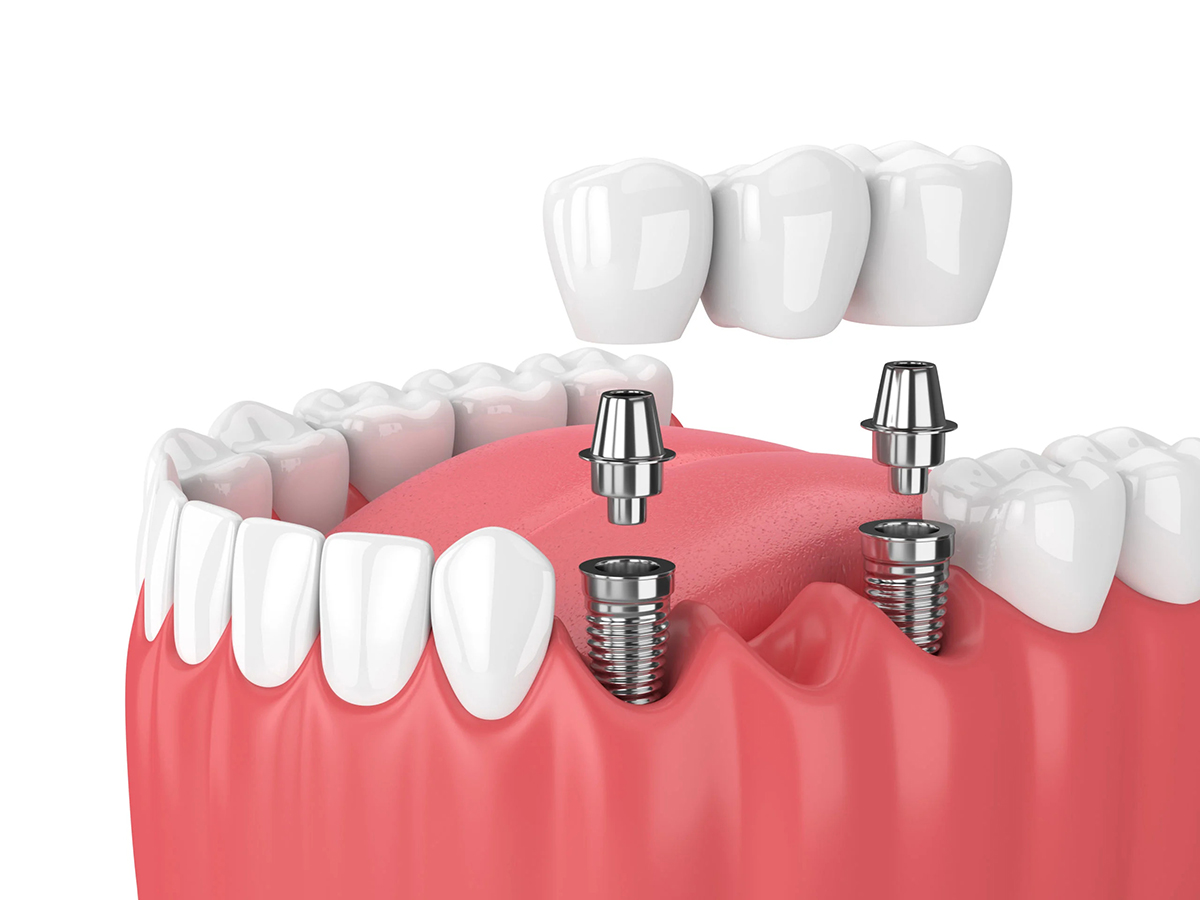Home>Finance>How Much Does A Dental Bridge Cost With Insurance?


Finance
How Much Does A Dental Bridge Cost With Insurance?
Modified: December 30, 2023
Find out the cost of dental bridge with insurance and explore financing options. Achieve a healthy smile without breaking the bank.
(Many of the links in this article redirect to a specific reviewed product. Your purchase of these products through affiliate links helps to generate commission for LiveWell, at no extra cost. Learn more)
Table of Contents
Introduction
Welcome to our comprehensive guide on dental bridges and their associated costs. If you’re dealing with missing teeth and seeking a solution that can restore your smile and improve functionality, dental bridges could be the answer. However, before diving into the cost aspect, it is crucial to understand what dental bridges are and why they are important.
Dental bridges are prosthetic devices used to replace one or more missing teeth. They are designed to “bridge” the gap between remaining natural teeth or dental implants. Not only do they restore the appearance of a complete smile, but they also help maintain proper oral functionality, such as chewing and speaking.
By providing a stable and natural-looking tooth replacement option, dental bridges can have a significant impact on a person’s confidence and overall oral health. However, it’s essential to be aware that the cost of dental bridges can vary depending on several factors.
In this article, we’ll explore the different types of dental bridges available, the factors that influence their cost, and how insurance coverage can impact the overall expense. We’ll also touch on other financial considerations that individuals should take into account when considering dental bridges.
Before we delve into the specifics, it’s important to note that while this article provides general information, consulting with a dental professional is crucial. They can assess your unique dental situation and provide you with accurate cost estimates and treatment recommendations.
Now, let’s explore the world of dental bridges and discover how they can transform your smile!
Understanding Dental Bridges
Dental bridges are a popular option for replacing missing teeth and restoring the function and aesthetics of your smile. As mentioned earlier, they “bridge” the gap created by missing teeth, using artificial teeth to fill in the space.
Typically, dental bridges consist of two main components: the pontics (artificial teeth) and the abutments (supporting structures). The pontics are custom-made to match the shape, size, and color of your natural teeth, ensuring a seamless blend with your existing smile. The abutments, on the other hand, are dental crowns placed on the neighboring teeth or dental implants, providing stability and support to the bridge.
There are several benefits to choosing dental bridges as a tooth replacement option. Firstly, they can restore proper chewing and speaking abilities, improving overall oral function. Secondly, dental bridges can help maintain the alignment of your teeth by preventing them from shifting into the empty space left by a missing tooth. Additionally, they can enhance your appearance by filling in the gaps and giving you a complete, natural-looking smile.
It’s important to note that dental bridges require proper oral care and hygiene to ensure their longevity and effectiveness. Regular brushing, flossing, and dental check-ups are essential to maintain the health of the supporting teeth and gums.
Now that we have a better understanding of dental bridges, let’s explore the different types available.
Types of Dental Bridges
When it comes to dental bridges, there are several types available, each designed to suit different dental needs and preferences. Here are some of the most common types:
- Traditional Dental Bridges: Traditional bridges are the most common type and consist of a pontic (artificial tooth) held in place by dental crowns on the adjacent natural teeth. These teeth, known as abutment teeth, are prepared by removing a portion of their enamel to ensure a proper fit for the crowns. Traditional bridges are an excellent option for patients who have strong and healthy neighboring teeth.
- Cantilever Dental Bridges: Cantilever bridges are similar to traditional bridges but differ in the way they are supported. Instead of being held in place by dental crowns on both sides, they are supported by a single dental crown on one side. Cantilever bridges are suitable when there is only one adjacent tooth available for support.
- Maryland Dental Bridges: Maryland bridges, also known as resin-bonded bridges, are a conservative option that uses a metal or porcelain framework. This framework is bonded to the back of the adjacent teeth without the need for extensive preparation or dental crowns. Maryland bridges are an ideal choice for patients with strong and healthy neighboring teeth.
- Implant-Supported Dental Bridges: Implant-supported bridges are considered the most durable and stable option for dental bridges. They are supported by dental implants that are surgically placed into the jawbone, acting as artificial tooth roots. These dental implants provide a strong foundation for the bridge and offer additional benefits, such as preventing bone loss in the jaw. Implant-supported bridges are suitable for patients with multiple missing teeth and are a long-lasting solution.
The choice of dental bridge type depends on various factors, including the location of the missing teeth, the condition of the neighboring teeth, and the individual’s budget. Consulting with a dental professional is essential to determine the most suitable type of dental bridge for your specific dental needs.
Now that we have explored the different types of dental bridges, let’s move on to understanding the factors that can affect the cost of dental bridges.
Factors that Affect the Cost of Dental Bridges
The cost of dental bridges can vary widely depending on several factors. Understanding these factors can help you get a better idea of what to expect in terms of cost. Here are some key factors that can influence the cost of dental bridges:
- Bridge Type: The type of dental bridge you choose will have a significant impact on the cost. Traditional bridges are usually the most affordable option, while implant-supported bridges tend to be more expensive due to the additional cost of dental implant surgery.
- Number of Teeth to Replace: The number of missing teeth that need to be replaced will affect the cost. Naturally, a bridge that replaces a single missing tooth will be less expensive than one replacing multiple teeth.
- Material Used: The material used for the pontics and dental crowns can affect the cost. Porcelain and porcelain fused to metal bridges are popular choices due to their natural appearance and durability, but they tend to be more expensive than metal or resin bridges.
- Location: The location of the dental practice can also impact the cost. Dental services in urban areas or areas with a higher cost of living may have higher prices compared to those in more rural or low-cost areas.
- Dentist’s Experience and Reputation: The experience and expertise of the dentist performing the procedure can influence the cost. Dentists with a higher level of experience and a good reputation may charge higher fees.
- Additional Procedures: In some cases, additional procedures may be required before or during the placement of the dental bridge. This can include tooth extraction, bone grafting, or periodontal treatment, which can add to the overall cost.
- Dental Insurance Coverage: Dental insurance coverage can significantly affect the out-of-pocket cost of dental bridges. Insured individuals may have a portion or the entire cost covered, depending on their specific insurance plan.
It’s important to note that while cost is an important factor, it’s equally important to prioritize the quality and long-term durability of your dental bridge. Cutting corners on cost may result in a bridge that doesn’t last as long or provide optimal aesthetics and function.
Now that we have discussed the factors that can impact the cost of dental bridges, let’s delve into how dental bridge costs can be affected by insurance coverage.
Dental Bridge Cost with Insurance
Insurance coverage can play a significant role in reducing the cost of dental bridges. Many dental insurance plans include coverage for restorative procedures like dental bridges, although the extent of coverage can vary depending on the specific insurance policy. It’s essential to review your insurance plan and understand the details of your coverage.
Typically, dental insurance plans cover a portion of the cost of dental bridges, with the remaining amount to be paid by the patient. The percentage of coverage can vary, but it is common for insurance to cover around 50% of the cost. However, some insurance plans may have a maximum annual coverage limit, so it’s important to be aware of any limitations.
Additionally, insurance companies may have certain requirements for coverage. This could include a waiting period before dental bridge treatment, documentation of the need for the bridge, or obtaining pre-authorization for the procedure. It’s essential to follow the guidelines set by your insurance provider to ensure eligibility for coverage.
When considering the cost of dental bridges with insurance, it’s important to remember that insurance coverage is typically for the basic cost of the bridge. Additional procedures or upgrades, such as using porcelain instead of metal for the pontics or dental crowns, may result in extra out-of-pocket expenses. It’s advisable to discuss all potential costs and coverage limitations with your dentist and insurance provider before undergoing treatment.
If you have dental insurance, it is recommended to consult with your insurance provider and dentist to determine the exact coverage for dental bridges. They will be able to provide you with a breakdown of the estimated costs and what portion will be covered by insurance. This knowledge will help you plan and budget accordingly.
Now that we have covered dental bridge cost with insurance, let’s explore the scenario of dental bridge cost without insurance.
Dental Bridge Cost without Insurance
If you do not have dental insurance, the cost of dental bridges can vary depending on several factors, as mentioned earlier. It’s important to note that without insurance coverage, you will be responsible for covering the full cost of the dental bridge out of pocket.
The cost of a dental bridge without insurance can range from a few hundred dollars to several thousand dollars per tooth. The overall cost will be influenced by factors such as the type of dental bridge, the number of teeth being replaced, the materials used, and the location of the dental practice.
Traditional dental bridges are generally more affordable than implant-supported bridges, for example. The materials used for the pontics and dental crowns can also impact the cost, with porcelain and porcelain-fused-to-metal bridges being pricier compared to metal or resin bridges.
It’s important to keep in mind that the cost of the dental bridge itself is not the only expense. Additional costs may include dental consultations, any necessary tooth preparation procedures, and follow-up appointments. These costs can add up and should be considered when budgeting for the overall expense.
While the upfront cost of dental bridges without insurance may seem high, it’s essential to consider the long-term benefits they provide. Dental bridges can substantially improve your oral health, overall function, and self-confidence. They are a durable and reliable tooth replacement option that can last for many years with proper care.
If you do not have dental insurance and are concerned about the cost of dental bridges, it’s worth exploring other financial options. Some dental practices offer payment plans or financing options to help make the cost more manageable. It’s important to discuss these options with your dentist and explore what works best for your financial situation.
Now that we have covered the scenario of dental bridge cost without insurance, let’s touch on other financial considerations when it comes to dental bridges.
Other Financial Considerations
When considering dental bridges, it’s important to take into account additional financial considerations beyond the direct cost of the procedure. These factors can have an impact on your overall budget and financial planning. Here are some important points to consider:
- Long-Term Value: While dental bridges may require a significant upfront investment, it’s important to consider their long-term value. Dental bridges can improve your oral health, restore your smile, and enhance your overall quality of life. Investing in a durable and well-fitted bridge can provide you with years of functionality and confidence.
- Oral Health Maintenance: Proper maintenance and regular dental check-ups are essential for the longevity of your dental bridge. It’s crucial to budget for ongoing dental cleanings, examinations, and potential repairs or adjustments that may be needed.
- Insurance Alternatives: If traditional dental insurance is not an option for you, it may be worth exploring alternative options such as dental discount plans or dental savings plans. These programs can provide reduced fees for dental procedures, including dental bridges.
- Flexible Spending Accounts (FSAs) or Health Savings Accounts (HSAs): If you have access to an FSA or HSA through your employer, you can set aside pre-tax dollars specifically for dental expenses. Utilizing these accounts can help offset the cost of dental bridges.
- Payment Plans and Financing Options: Many dental practices offer payment plans or financing options for patients who need assistance in managing the cost of dental bridges. These options allow you to spread out the payments over time, making them more affordable and manageable.
- Seeking Multiple Opinions: It can be beneficial to consult with multiple dentists to get different opinions and cost estimates for dental bridges. This can help you compare pricing and ensure that you are getting the best value for your money.
By considering these additional financial factors, you can make a more informed decision about dental bridges and plan accordingly for the costs involved.
Now, let’s conclude our comprehensive guide on dental bridge costs and the various financial considerations associated with them.
Conclusion
Dental bridges offer a practical and aesthetically pleasing solution for replacing missing teeth. The cost of dental bridges can vary based on factors such as bridge type, materials used, number of teeth being replaced, and your location. Dental insurance coverage can help reduce the cost, but it’s important to understand your specific coverage and any limitations.
For those without insurance, the cost of dental bridges can be a significant investment. However, it’s essential to consider the long-term value and benefits they provide in terms of oral health, functionality, and confidence. Exploring payment plans, alternative insurance options, and utilizing FSAs or HSAs can help make the cost more manageable.
When considering dental bridges, it’s crucial to consult with a dental professional who can provide accurate cost estimates and treatment recommendations tailored to your specific dental needs. They can guide you through the process, explain the various options, and assist with any financial inquiries or concerns you may have.
Remember, while cost is an important factor, prioritizing the quality and durability of your dental bridge is equally vital. Cutting corners on cost may lead to issues in the long term and compromise the functionality and aesthetic appeal of your bridge.
If you’re considering dental bridges, take the time to weigh the costs, benefits, and financial considerations. Investing in a well-fitted dental bridge can make all the difference in restoring your smile and confidence.
Ultimately, dental bridges can provide a long-lasting solution for missing teeth, helping you regain the ability to chew, speak, and smile with confidence. By understanding the factors that affect their cost and exploring available financial options, you can make an informed decision and embark on your journey to a beautiful, complete smile.














